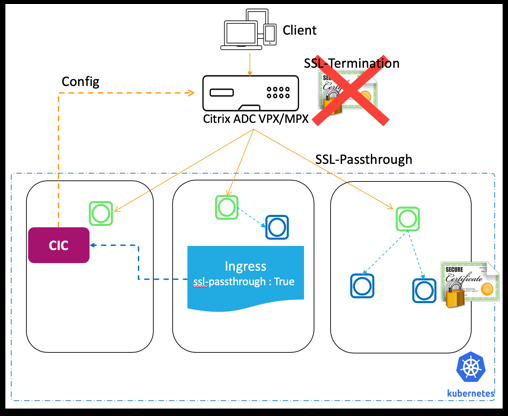-
-
-
Deploy NetScaler ingress controller with OpenShift router sharding support
-
Deploy NetScaler CPX™ as an Ingress in Azure Kubernetes Engine
-
Deploy NetScaler ingress controller in an Azure Kubernetes Service cluster with NetScaler VPX™
-
Deploy NetScaler ingress controller for NetScaler with admin partitions
-
Multi-cloud and GSLB solution with Amazon EKS and Microsoft AKS clusters
-
-
SSL certificate for services of type LoadBalancer through the Kubernetes secret resource
-
BGP advertisement for type LoadBalancer services and Ingresses using NetScaler CPX
-
NetScaler CPX integration with MetalLB in layer 2 mode for on-premises Kubernetes clusters
-
Advanced content routing for Kubernetes Ingress using the HTTPRoute CRD
-
IP address management using the NetScaler IPAM controller for Ingress resources
-
This content has been machine translated dynamically.
Dieser Inhalt ist eine maschinelle Übersetzung, die dynamisch erstellt wurde. (Haftungsausschluss)
Cet article a été traduit automatiquement de manière dynamique. (Clause de non responsabilité)
Este artículo lo ha traducido una máquina de forma dinámica. (Aviso legal)
此内容已经过机器动态翻译。 放弃
このコンテンツは動的に機械翻訳されています。免責事項
이 콘텐츠는 동적으로 기계 번역되었습니다. 책임 부인
Este texto foi traduzido automaticamente. (Aviso legal)
Questo contenuto è stato tradotto dinamicamente con traduzione automatica.(Esclusione di responsabilità))
This article has been machine translated.
Dieser Artikel wurde maschinell übersetzt. (Haftungsausschluss)
Ce article a été traduit automatiquement. (Clause de non responsabilité)
Este artículo ha sido traducido automáticamente. (Aviso legal)
この記事は機械翻訳されています.免責事項
이 기사는 기계 번역되었습니다.책임 부인
Este artigo foi traduzido automaticamente.(Aviso legal)
这篇文章已经过机器翻译.放弃
Questo articolo è stato tradotto automaticamente.(Esclusione di responsabilità))
Translation failed!
Configure SSL passthrough using Kubernetes Ingress
SSL passthrough feature allows you to pass incoming security sockets layer (SSL) requests directly to a server for decryption rather than decrypting the request using a load balancer. SSL passthrough is widely used for web application security and it uses the TCP mode to pass encrypted data to servers.
The proxy SSL passthrough configuration does not require the installation of an SSL certificate on the load balancer. SSL certificates are installed on the back end server as they handle the SSL connection instead of the load balancer.
The following diagram explains the SSL passthrough feature.

As shown in this diagram, SSL traffic is not terminated at the NetScaler and SSL traffic is passed through the NetScaler to the back end server. SSL certificate at the back end server is used for the SSL handshake.
The NetScaler Ingress Controller provides the following Ingress annotation that you can use to enable SSL passthrough on the Ingress NetScaler:
ingress.citrix.com/ssl-passthrough: 'True|False'
The default value of the annotation is False.
SSL passthrough is enabled for all services or host names provided in the Ingress definition. SSL passthrough uses host name (wildcard host name is also supported) and ignores paths given in Ingress.
Note:
The NetScaler Ingress Controller does not support SSL passthrough for non-hostname based Ingress. Also, SSL passthrough is not valid for default back end Ingress.
To configure SSL passthrough on the Ingress NetScaler, you must define the ingress.citrix.com/ssl-passthrough: as shown in the following sample Ingress definition. You must also enable TLS for the host as shown in the example.
apiVersion: networking.k8s.io/v1
kind: Ingress
metadata:
annotations:
ingress.citrix.com/frontend-ip: x.x.x.x
ingress.citrix.com/insecure-termination: redirect
ingress.citrix.com/secure-backend: "True"
ingress.citrix.com/ssl-passthrough: "True"
name: hotdrinks-ingress
spec:
ingressClassName: citrix
rules:
- host: hotdrinks.beverages.com
http:
paths:
- backend:
service:
name: frontend-hotdrinks
port:
number: 443
path: /
pathType: Prefix
tls:
- secretName: beverages
<!--NeedCopy-->
Share
Share
In this article
This Preview product documentation is Cloud Software Group Confidential.
You agree to hold this documentation confidential pursuant to the terms of your Cloud Software Group Beta/Tech Preview Agreement.
The development, release and timing of any features or functionality described in the Preview documentation remains at our sole discretion and are subject to change without notice or consultation.
The documentation is for informational purposes only and is not a commitment, promise or legal obligation to deliver any material, code or functionality and should not be relied upon in making Cloud Software Group product purchase decisions.
If you do not agree, select I DO NOT AGREE to exit.